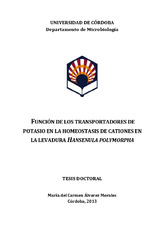Función de los transportadores de potasio en la homeostasis de cationes en la levadura Hansenula polymorpha
Autor
Álvarez Morales, María del Carmen
Director/es
Ramos, JoséEditor
Universidad de Córdoba, Servicio de PublicacionesFecha
2013Materia
Homeostasis de cationesCationes celulares
Hansenula polymorpha
Homeostasis de iones
Levaduras
Microorganismos
Potasio
METS:
Mostrar el registro METSPREMIS:
Mostrar el registro PREMISMetadatos
Mostrar el registro completo del ítemResumen
La homeostasis de cationes es fundamental para las células vivas.
Parámetros fisiológicos de relevante importancia para la célula como son el
volumen celular, el pH intracelular, el potencial de membrana o la concentración
interna de cationes dependen de los sistemas de entrada y salida de los principales
cationes celulares, como son el sodio y el potasio.
En este trabajo de Tesis hemos utilizado la levadura Hansenula polymorpha
para avanzar en el estudio de la homeostasis de cationes en levaduras.
H. polymorpha es una levadura “no convencional” de gran interés y potencial
utilidad en procesos biotecnológicos. Se trata de una levadura metilotrófica y
termotolerante, capaz de crecer a más de 50 ºC. De igual manera que en la
levadura Saccharomyces cerevisiae, H. polymorpha posee dos genes que participan
en el transporte de potasio, pero a diferencia de lo que sucede en la levadura
modelo en la que ambos genes pertenecen a la misma familia (TRK1,2), en H.
polymorpha existe sólo un representante de Trk (TRK1) y otro gen
filogenéticamente diferente, denominado HAK1 (High-Affinity-K+). Utilizando
mutantes en los sistemas de transporte de potasio de esta levadura, hemos
caracterizado los requerimientos de potasio y la tolerancia a sal, hemos estudiado
los flujos de potasio y sodio y asimismo hemos identificado algunos procesos
implicados en su regulación.
Los resultados de este trabajo mostraron que la disrupción de alguno de
los genes, HAK1 o TRK1, condujo a un crecimiento defectuoso a concentraciones
bajas de potasio, siendo este hecho especialmente relevante en el caso de la
disrupción de HAK1. Los ensayos de flujo de Rb⁺, como catión análogo al K⁺,
demostraron que el transportador Hak1 tiene una alta afinidad de absorción,
mientras que la afinidad estimada para Trk1 fue varias veces inferior. Además, se
concluyó que la expresión de HAK1 se induce en condiciones limitantes de K⁺ y... Cation homeostasis is essential for living cells. Important physiological
parameters for the cell such as cell volume, intracellular pH, membrane potential
or the internal cation concentration are affected by the influx and efflux systems of
potassium and sodium alkali cations.
In this work we have used Hansenula polymorpha to advance in the study
of cation homeostasis in yeast. H. polymorpha is a methylotrophic thermotolerant
non-conventional yeast. The increasing interest on this organism is based on the
great diversity of areas in which it can be useful, for example in the field of
industrial microbiology. Unlike what happens in the model yeast Saccharomyces
cerevisiae, in which the two genes involved in potassium transport belong to the
same family of transporters (TRK1,2), in H. polymorpha there is only one
representative of Trk (TRK1) and another phylogenetically different gene, called
HAK1 (High-Affinity-K⁺). Using mutants in the potassium transport systems of this
yeast, we have characterized the potassium requirements and salt tolerance, we
have studied the potassium and sodium fluxes and we have also identified some
processes involved in their regulation.
The results of this study showed that the disruption of any of the genes,
TRK1 or HAK1, led to an impaired growth at low potassium concentrations, being
this fact particularly important in the case of the disruption of HAK1. The Rb⁺ (K⁺)
uptake rates showed high affinity of Hak1 for K⁺, while the affinity estimated for
Trk1 was several orders of magnitude lower. Furthermore it was concluded that
HAK1 expression is induced at limiting-K⁺ conditions and is regulated by the
presence of K⁺, while TRK1 is not regulated transcriptionally.
With respect to sodium transport, it has been demonstrated that there is
no specific high-affinity transport for this cation. When compared to wild type,
strains lacking Trk1 transporter have a greater sensitivity to sodium and lithium,
accumulate higher amounts of these cations during growth, have a faster transport...

